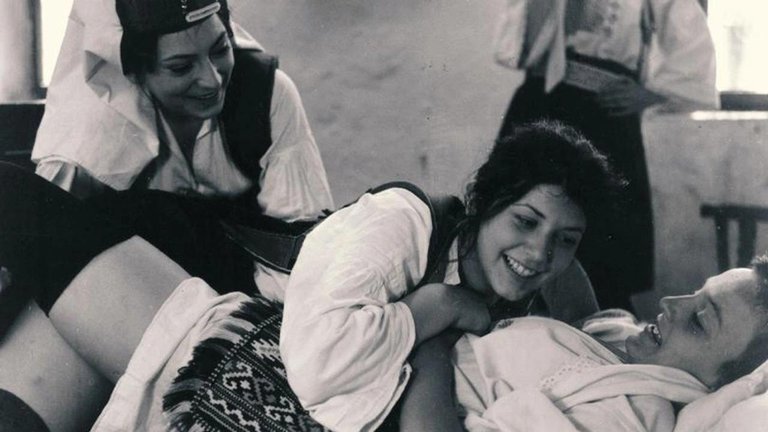
The Yugoslav Black Wave, a cinematic movement synonymous with subversive critique and avant-garde storytelling, is often framed within the context of Serbian directors like Dušan Makavejev or Želimir Žilnik. Yet, it was the Croatian filmmaker Krsto Papić who crafted one of the movement’s most enduring works: Handcuffs (1970). This period drama, set against the backdrop of Tito’s ideological purges, has been lauded by Croatian critics as the pinnacle of national cinema, a film that transcends regional categorisation to stand as a cornerstone of Yugoslav film history. While Serbian auteurs dominated the Black Wave’s international recognition, Papić’s Handcuffs — co-written with Mirko Kovač, a literary provocateur — remains a testament to Croatia’s contribution to this audacious movement. Its unflinching portrayal of political paranoia and societal hypocrisy not only challenged Yugoslavia’s socialist orthodoxy but also cemented Papić’s legacy as a master of allegorical storytelling.
Set in the Dalmatian hinterland in 1948, Handcuffs unfolds during a precarious moment in Yugoslav history: the aftermath of Tito’s split from Stalin, a period marked by brutal purges of suspected Soviet sympathisers. Against this tension, middle-aged Ante (played by Fabijan Šovagović) prepares to marry his youthful bride Višnja (played by Jagoda Kaloper). The wedding, however, is gatecrashed by two UDBA agents, Krešo (played by Ilija Ivezić) and Ćazim (played by Fahro Konjhodžić), whose presence casts a pall over the festivities. Ante, haunted by past regime changes, fears he may be their target, while his best man Andrija (played by Adem Ćejvan), a smug Party official, assures the crowd of his protective influence. Yet, Andrija’s arrogance ignites chaos: his casual cruelty toward the village fool Musa (played by Ivica Vidović) — culminating in the attempted killing of Musa’s pet bird — spirals into collective violence. The film’s tragic irony peaks when the agents’ true target is revealed, exposing the fragility of loyalty in a state ruled by fear.
Papić’s narrative is a masterclass in suspense, blending the claustrophobia of a single-day timeline with the expansive dread of political surveillance. The villagers’ forced merriment, juxtaposed with the agents’ lurking menace, mirrors Yugoslavia’s broader climate of distrust.
Co-written by Papić and Mirko Kovač — a screenwriter renowned for his incendiary critiques of Yugoslav society — Handcuffs dismantles the myth of socialist egalitarianism. The Communist Party is depicted not as a vanguard of the people but as a cabal of petty psychopaths, wielding power with feudal arrogance. Andrija, the Party loyalist, embodies this hypocrisy: his veneer of authority crumbles to reveal a man intoxicated by control, indifferent to the suffering he incites. Meanwhile, the villagers — ostensibly the backbone of state power — are portrayed as cowardly conformists, quick to redirect their frustrations onto the vulnerable, such as Musa or Višnja. This bleak portrayal of both rulers and ruled strips bare the contradictions of Yugoslav socialism, where ideological promises collided with the realities of corruption and systemic violence. Remarkably, Handcuffs was produced under Tito’s regime, a fact that strains credulity given its scathing critique.
Among the film’s most daring sequences is the arrival of a Franciscan monk (Stjepan Bahert), who chastises Ante for eschewing a church wedding — a direct jab at Yugoslavia’s policy of state atheism. The monk’s lament that the villagers have “forgotten God” is a thinly veiled critique of Communist attempts to erase religious identity. This scene, radical for its time, foreshadows post-Yugoslav critiques of secular authoritarianism, as if Papić had peered decades ahead into a future where both Communism and Yugoslavia would dissolve. The inclusion of religious dissent not only underscores the film’s subversiveness but also highlights the enduring cultural tensions between tradition and state-enforced modernity.
Technically, Handcuffs is unmistakably a product of its era. Shot in stark black-and-white, the film’s visual austerity amplifies its grim atmosphere. The karst landscapes of Mt. Dinara — barren and unforgiving — mirror the villagers’ existential desolation. Papić’s decision to confine the plot to a single day, with tension simmering beneath surface-level rituals, lends the film a Western-like structure, where the threat of violence looms as palpably as in a frontier showdown.
The absence of a conventional soundtrack further heightens the unease. Traditional folk songs and the eerie silence of a music-less kolo (circle dance) evoke a community stripped of joy, their cultural practices reduced to hollow performances.
Papić’s commitment to authenticity extends to his use of non-professional actors from Vrlika, a Dalmatian village near Sinj (notably the ancestral home of Canadian actress Stana Katić). Their participation, coupled with meticulous attention to traditional costumes and customs, transforms Handcuffs into an ethnographic study of rural Dalmatia. The villagers’ dialects, rituals, and even their resigned fatalism reflect a deep-rooted cultural identity resistant to political upheaval.
Amid the gloom, Papić inserts moments of dark humour and subtle rebellion. A scene where Višnja playfully interacts with her bridesmaid — often interpreted as Yugoslav cinema’s first hint of same-sex erotica — offers a fleeting glimpse of autonomy in a patriarchal society. Similarly, a villager’s plea for Andrija to secure his son a government job — despite the boy’s obvious incompetence — satirises the nepotism and absurdity of state bureaucracy. For contemporary audiences, at least those who had misfortune of dealing with Croatian bureaucracy, this scene is not only funny but eerily prophetic, since so many future Andrijas said “yes” in similar situations.
Handcuffs endures not merely as a Black Wave classic but as a prophetic allegory of Yugoslavia’s unraveling. Its depiction of communal violence and institutional rot foreshadowed the ethnic tensions that would erupt decades later. Though initially suppressed in Serbia for its “anti-Yugoslav” themes, the film’s international acclaim — including a Golden Arena at the Pula Film Festival — solidified its status as a landmark of political cinema.
RATING: 8/10 (+++)
Blog in Croatian https://draxblog.com
Blog in English https://draxreview.wordpress.com/
InLeo blog https://inleo.io/@drax.leo
Hiveonboard: https://hiveonboard.com?ref=drax
InLeo: https://inleo.io/signup?referral=drax.leo
Rising Star game: https://www.risingstargame.com?referrer=drax
1Inch: https://1inch.exchange/#/r/0x83823d8CCB74F828148258BB4457642124b1328e
BTC donations: 1EWxiMiP6iiG9rger3NuUSd6HByaxQWafG
ETH donations: 0xB305F144323b99e6f8b1d66f5D7DE78B498C32A7
BCH donations: qpvxw0jax79lhmvlgcldkzpqanf03r9cjv8y6gtmk9
Posted Using INLEO